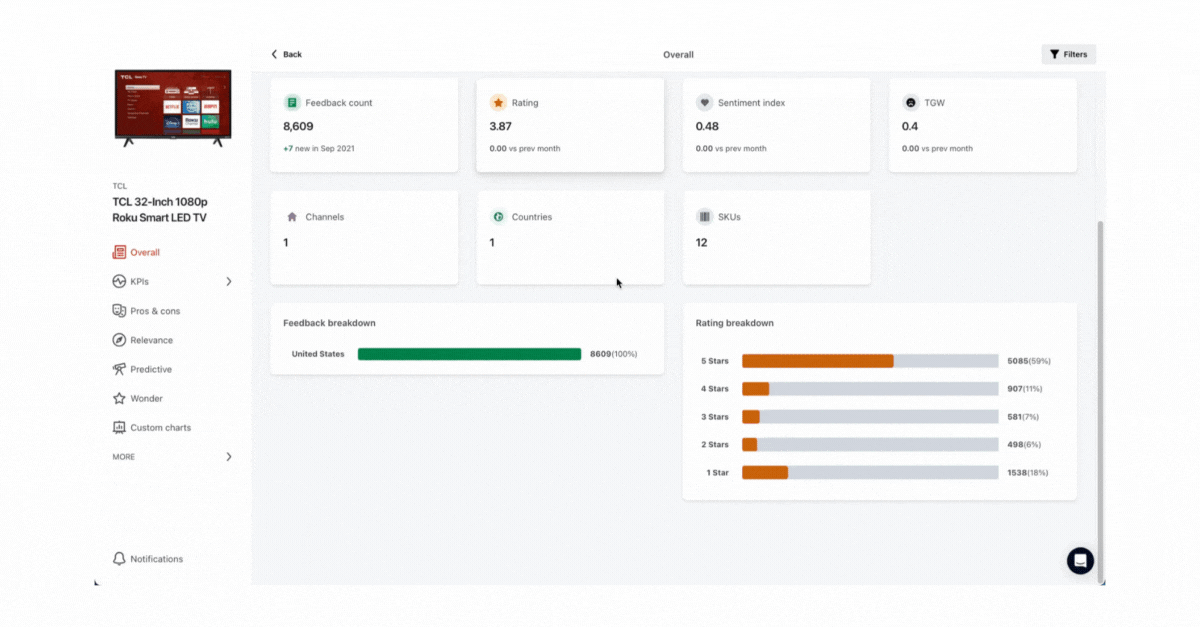How TV Marketers Can Use Consumer Feedback for Black Friday & Cyber Monday



Black Friday (November 24th) and Cyber Monday (November 27th), are both less than a week away, and this can mean different things for thousands of U.S. consumers and businesses alike as they rally up for this monumental (and overwhelming) weekend. For consumers, it can certainly mean it's time to set up tent (and even fight) until 5 AM when stores open to snag the best deals. For eCommerce and retailers, consumer electronics in particular (Amazon, Walmart, Target, Best Buy, Apple, RadioShack - you name it), it means gearing up with the best save-or-die-trying strategies and deals. Specifically those selling televisions (TVs), a major category set to blow out every year during this time. Before we dive into original insights found nowhere else - what consumers are actually saying are the best TVs - we thought it interesting to show a little history on what created the exciting Frankenstein that is Black Friday.
According to history, the first sightings (or rather, use of the term) of 'Black Friday' started off around the 1800s and rather dark, with ties to financial crashes (e.g., the U.S. gold market in 1869) instead of anything Thanksgiving-related, as many of us thought. Of the many versions of the story behind this shopping phenomenon, we've stuck to the most common one - the one involving retailers. For accounting purposes, retail companies would record their revenue losses in red and profits in black. So, for instance, after a whole year of operating at a loss (“in the red”), businesses would apparently earn a profit (“went into the black”) on the day after Thanksgiving because customers went crazy on holiday deals and discounts. Again, this version of Black Friday's origin stuck the most (even if the accounting part is only true!).
As for Cyber Monday, Retail Insider's interview with a Black Friday analyst of over ten years shares that "around 2005, The US industry group representing ‘pure play’ online sellers, a fairly new phenomenon, created Cyber Monday, to generate their own non-store event." Following this, retailers joined forces with e-commerce sellers, capitalizing on this. Cyber Monday basically "extends Black Friday weekend by another day and with just a new name.” Nowadays, the huge weekend traditionally signals the start of Christmas shopping with stores offering big discounts to reel in shoppers.
Demand for consumer electronics remained strong as households globally upgraded in-home entertainment during the COVID-19 pandemic, televisions in particular. The TV market's revenue amounts to US$97.3bn in 2023. In a global comparison, most revenue is generated in the U.S. (US$18,040.0m in 2023). 2022-2023, emphasizing the integral role of TVs in American households. According to CNBC, back in 2022, television prices dipped by 17% — which may have translated to steep discounts for shoppers on Black Friday and Cyber Monday and there's no doubt it will be similar this year as big brands like Sony, Samsung, LG, TCL, and more, slash prices even more. Some of the key consumer trends related to TV purchases are as follows:
The demand for smart TVs with advanced streaming capabilities and integrated voice assistants is on the rise. A recent survey of U.S. consumers concluded that 79% of consumers would prefer a smart TV over a 3D or curved screen alternative because it serves as an 'intuitive and versatile' option. In fact, according to our data of over 100,000 TV ratings and reviews, Ease of Use is one of the main aspects that customers evaluate when reviewing TVs in general, with 20% of customers leaving positive comments about Ease of Use.
.png)

Connected TVs (CTVs) have become the norm, with 78% of US homes having at least one connected device. No surprise that it’s not just TV manufacturers who have taken notice and begun to develop gaming-led entertainment systems like Apple TV and Amazon Fire TV. Gaming has penetrated the mainstream, and customers are calling out the TV Performance aspect of gaming in their reviews:
.png)
Consumers continue to show a vested interest in conscious TV brands, with a company’s holistic ethos influencing purchasing decisions. Recent studies and market trends maintain that 55% of consumers are willing to pay more for eco-friendly brands. Consumer electronic companies have become greener in order to survive. Samsung is one of the many consumer tech giants that have pledged to increase their use of eco-conscious materials and recycled materials while adapting products to be more accessible to the visually, audibly, physically, and intellectually disabled. And talking about sustainability, one aspect that customers don’t accept is when their device breaks down after a few months or years of use, especially if this happens right after the end of the warranty period:
.png)
In this section, we look at several highly-rated TV models according to our Business Intelligence --- what aspects consumers rate positively (and why) and a TV aspect requiring improvement (which competing brands may consider as an opportunity).
.png)
The LG NanoCell Smart TV is a very popular product in the market with a good rating of 4.34, and around 70% of customers give it a 5-star rating. The aspects that customers appreciate the most about this product are its Picture, the Ease of Use, and its Sound:
.png)
.png)
.png)
With a very high rating of 4.56, the Sony Bravia OLED Smart TV was launched last year and has received a great response from customers. Picture and Sound are by far the aspects that customers appreciate the most, followed by its Ease of Use. The quality of “Colors” is particularly standing out compared to the other products analyzed in this article, with customers often using the word vibrant to describe it.
.png)
.png)
.png)
The Samsung Crystal UHD 4K is another great option on the market. Its overall rating is high and stable, sitting at 4.46, while the amount of reviews collected online has been growing fast in recent years.
.gif)
While Picture, Sound and Ease of Use are the most commented positive aspects, similarly to the other analyzed products, this Samsung stands out for its Price and, in particular, for its Value for Money ratio, with twice the amount of customers satisfied about this aspect compared to the other two products (14% for Samsung and 7% for Sony and LG):
.png)
.png)
.png)
Last but not least, the TP Vision Philips 9000 Series reaches a rating of 4.48, making it a good option to be considered for Black Friday. Sound is definitely the aspect that stands out for this TV, with one-third of all reviews expressing positive comments about it. Additionally, Design is also a topic where this product stands out versus others, with a particular mention of the Ambilight feature:
.png)
E-commerce and brick-and-mortar retail stores witness a substantial uptick in sales as consumers eagerly seize the opportunity to snag the latest TV models at irresistible prices. Online reviews are a key source of information for all consumers looking to buy a TV during this time --- and for businesses to stay ahead of consumer demands.
Several things for product managers, marketers, and decision-makers to consider: Create clearer user instructions and overall marketing communications.
Some TV aspects are non-negotiable to stand out in this category, such as Picture Quality, Sound, and the Ease of Use. So make sure that your customers know that they are buying a high-quality product when it comes to these aspects and provide them with a clearer user manual, for example, on how to get the most out of their TV.
Highlight how your televisions tap into relevant category trends, (e.g. what makes your product the best for gaming?). With Generative AI incorporated into text analytics tools today, access to consumer reviews insights is not only in the blink of an eye, but it also generates personalized marketing messages for brands to instantly use.
.gif)
Understand what the strengths of your products are versus your competitors and communicate that clearly to attract customers looking for certain features. Natural language processing technologies like Wonderflow allow for advanced filtering of your brand's competitors in a grid-like overview, all within a single interface.
Advanced technologies powered by AI now help pinpoint exact causes of customer complaints and even recommend what product specs need improvement. With dozens of reviews being written daily, it's hard not to miss warning signs to opportunities in customer feedback. Third-party consumer sentiment software like Wonderflow addresses key enterprise pain points by being intuitive, easy to use, accurate, and instant.
As families gather for the holidays, the desire for enhanced entertainment experiences drives people to upgrade their home theaters. The allure of massive discounts and exclusive deals further fuels the TV-buying frenzy, with consumers seeking to elevate their viewing experiences at a fraction of the cost.
In this article, we've covered what consumers today generally seek in TV purchase decisions and shared several high-rated TV models that are dominating the market, and likely to be considered during Black Friday to Cyber Monday, plus what consumer electornics leaders should do to gain greater ROI, through leveraging customer feedback analytics like Wonderflow. Book a demo to learn more now!
